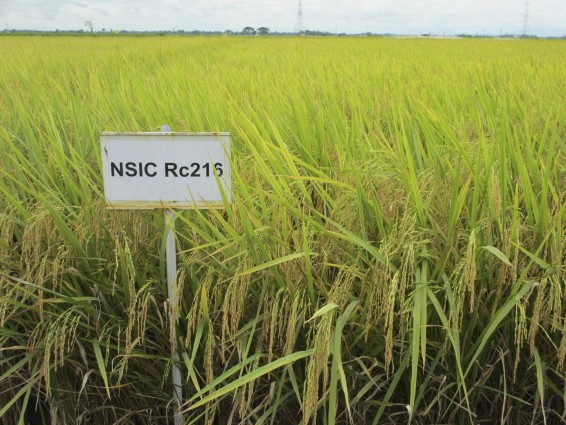It’s fascinating to find people who are well-versed in different aspects or those that are referred to as ‘jack-of-all-trades’. But what if this trait is applicable not only to humans, but also to rice?
Thanks to the breeding team headed by Ms. Thelma F. Padolina, a retired breeder of the Philippine Rice Research Institute (PhilRice). Through their efforts, NSIC Rc 216, a rice variety that works like a jack-of-all-trades, is making the farmers happy with its versatile trait. Almost nine years after its release, the variety remains relevant as it continues to rank as one of the Philippine’s most popular varieties.
Breeding history
Being versatile runs in the genes of Rc 216 because one of its parents, PJ7, was also a widely adapted-variety. PJ7 got its name from PhilRice and Japan International Cooperation Agency (JICA), the collaborators in the rice varietal improvement component of the Technical Cooperation Project on High Productivity Rice Technology. Aside from being versatile, Padolina described PJ7 as early maturing, has excellent milling quality, and has resistance to white stemborer in the irrigated lowland ecosystem. .
PJ7 became well-known because of its dual potential in irrigated and rainfed lowlands where yields were high under these conditions, especially during the wet season. PJ7 was renamed as Sinamar, an iloko term for “rays of hope”.
Despite these good traits, Padolina said that there is one disadvantage in using PJ7 – it is highly shattering. This trait paved way for the crossing of PJ7 with another variety called Matatag 1, which is also PhilRice-bred. This variety was chosen because it is moderate shattering, making it an ideal match for PJ7. With the crossing of these varieties, Rc 216 was bred.
The progeny
Rc 216 was released in 2009. It yields six tons per hectare on an average and 9.7 tons per hectare at most. It is moderately resistant to brown planthopper, green leafhopper, and stemborer.
Like its parent PJ7, Rc 216 has also wide adaptation under different stressful conditions from the wet condition of Caraga Region to the dry environment of Ilocos provinces. Unlike PJ7, Rc 216 is now moderately shattering.
Rc 216’s good performance is also reflected in some studies and survey. For instance, the socio-economic division survey of PhilRice listed Rc 216 as one of the top ten varieties planted by farmers in 2011 (wet season) and 2012 (dry season). The study titled, Farmers’ Preference for Rice Traits: Insights from Farm Surveys in Central Luzon, Philippines, 1966-2012, also listed Rc 216 as the most popular variety during the same period. This study also explained that with the release of varieties like Rc 216, more areas were planted to newer varieties during wet season.
Padolina also recalls anecdotal accounts she got from field monitoring and participatory varietal selection. Many of these accounts say that Rc 216 is excellent in terms of yield and grain quality. She also shares that the variety has good market price at P50 a kilo.
Way forward
With its very good traits, Padolina recommends Rc 216 for further breeding. She said under the current conditions, there are only few ‘flaws’ that need to be addressed in this variety.
Padolina also emphasized the importance of genetic diversity and that breeders must not stop breeding. She said that environment conditions continue to evolve through time. Using the same varieties over time, no matter how good they are, will make it susceptible to pests and diseases; that is why breeding institutions like PhilRice continue to breed new varieties. With wide array of varieties, farmers can easily access their preferred variety, wherever they are, whatever their condition.





